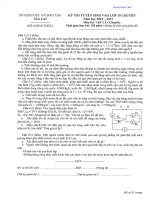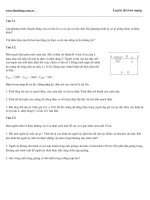VẬT lý địa CHẤN 03 geometry
Bạn đang xem bản rút gọn của tài liệu. Xem và tải ngay bản đầy đủ của tài liệu tại đây (502.45 KB, 26 trang )
Reflected, Refracted and Diffracted
waves
• Reflected wave from a horizontal layer
• Reflected wave from a dipping layer
• Refracted wave from a horizontal layer
• Refracted wave from a dipping layer
• Diffracted waves
Applications for shallow high
resolution Reflection seismic
•
•
•
•
•
Hydrogeological studies of acquifers
Engineering geology
Shallow faults
Mapping Quaternary deposits
Ground investigation for pipe and sewerage
tunnel detection
Applications for Refraction
seismic
•
•
•
•
•
Depth of groundwater level
Depth and location of hardrock
Elastic medium parameters
Permafrost
Glaciology
Refraction seismic
• Refracted Waves
• Mainly horizontal Wave propagation
• Only refracted waves are used. (Lower layer must
have higher velocity than upper layer)
• Distribution of velocity as well as the depth and
orientation of interfaces between layers
Reflection seismic
•
•
•
•
Reflected Waves (“Echo lot principal”)
Mainly vertical wave propagation
Complete seismic recording is used
Distribution of the velocity variation
Geometrical situation
Direct wave
Reflected wave
Refracted wave
Traveltime curve
Receivers
Source
Receivers
Direct wave
t
1
t= x
v
x
o
x
x
x
x
v
x
v=
t
Velocity of direct wave is derived from the distance and
travel time
Reflection: Horizontal reflector
x
A
B
x
o
4 S 2 = 4h 2 + x 2 = t 2 v 2
s
h
α
v
h
s
4h + x
t =
v2
2
x
2
2
t = t0 + 2 ,
v
2h
t0 =
v
2
2
2
Reflection: horizontal reflector
2
2
4
h
+
x
2
t =
v2
x
t = , for x >> h.
v
h
t2v2 = 4h2+x2
t2v2 - x2 = 4h2
t2v2 - x2 =1
4h2
4h2
Hyperbola
Moveout
1
Difference in travel time t(x1 ) und t(x2 ):
2
x22- x12
t2- t1 ≈
2v2t0
Normal Moveout
1
0
0
Difference in traveltime t
0
und t(x):
1
x12
∆T=t1- t0 ≈
2v2t0
t2v2=4h2+x2- 4hxcos(90+Θ)
X=-2hsinΘ
t2v2=4h2+x2+4hxsin(Θ)
Hyperbola:
∆Tdip
[x+2hsin(Θ)] 2
t2v2
=1
[2hcos(Θ)]2 - [2hcos(Θ)]2
-x
x
h
Θ
h
x
90+Θ
∆Tdip= tx-t-x = 2xsinΘ
v
Refraction seismic
sin ic
v1
v1
=
⇔ sin ic =
sin 90 v 2
v2
Propagation of seismic waves
Headwave
(Roth et al., 1998)
Direct wave
Reflected wave
Refracted wave
Traveltime curve
h
TSG = TSA + TAB + TBG = 2TSA + TAB
(
x − 2h tan ic )
h
=2
+
v1 cos ic
v2
x 2h cos ic
= +
v2
v1
Refraction: horizontal reflector
t
1
----v1
1
----v2
2
2
v2 – v 1
2h
x + -------------------t = --v2
v1 v 2
ti
x
xcross
x
t = ----- + t i
v2
x
h
v1
v2
v2 + v1
xcross = 2h -----------v 2 – v1
x sin(θ c + α ) 2 z a cosθ c
+
td =
v1
v1
For small slopes (α < 100):
x sin(θ c − α ) 2 zb cosθ c
+
v1
v1
vd + vu
v2 ≈
2
tu =
x sin(θ c + α ) 2 z a cosθ c
+
td =
v1
v1
For small slopes (α < 100):
x sin(θ c − α ) 2 zb cosθ c
+
v1
v1
vd + vu
v2 ≈
2
tu =
Huygens’ Principle:
Every point on a wavefront can be considered as a secondary
source of spherical waves
Surface
V=1.6 km/s
800 m
Reflection/Diffraction
Reflection:
tr≈ t0+δt
h
t0=2h/v
δt =x2/(4vh)
Reflection /Diffraction
Diffraction:
td≈ t0+2δt









